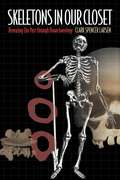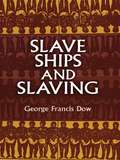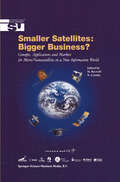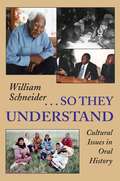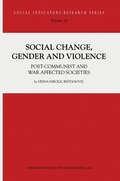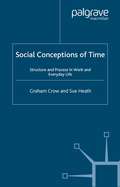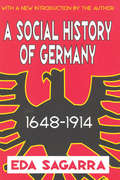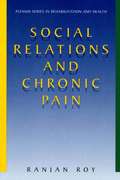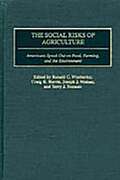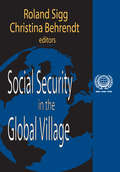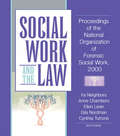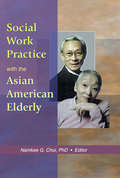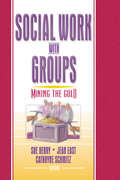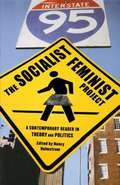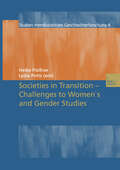- Table View
- List View
Skeletons in Our Closet: Revealing Our Past through Bioarchaeology
by Clark Spencer LarsenThe dead tell no tales. Or do they? In this fascinating book, Clark Spencer Larsen shows that the dead can speak to us--about their lives, and ours--through the remarkable insights of bioarchaeology, which reconstructs the lives and lifestyles of past peoples based on the study of skeletal remains. The human skeleton is an amazing storehouse of information. It records the circumstances of our growth and development as reflected in factors such as disease, stress, diet, nutrition, climate, activity, and injury. Bioarchaeologists, by combining the methods of forensic science and archaeology, along with the resources of many other disciplines (including chemistry, geology, physics, and biology), "read" the information stored in bones to understand what life was really like for our human ancestors. They are unearthing some surprises. For instance, the shift from hunting and gathering to agriculture approximately 10,000 years ago has commonly been seen as a major advancement in the course of human evolution. However, as Larsen provocatively shows, this change may not have been so positive. Compared to their hunter-gatherer ancestors, many early farmers suffered more disease, had to work harder, and endured a poorer quality of life due to poorer diets and more marginal living conditions. Moreover, the past 10,000 years have seen dramatic changes in the human physiognomy as a result of alterations in our diet and lifestyle. Some modern health problems, including obesity and chronic disease, may also have their roots in these earlier changes. Drawing on vivid accounts from his own experiences as a bioarchaeologist, Larsen guides us through some of the key developments in recent human evolution, including the adoption of agriculture, the arrival of Europeans in the Americas and the biological consequences of this contact, and the settlement of the American West in the eighteenth and nineteenth centuries. Written in a lively and engaging manner, this book is for anyone interested in what the dead have to tell us about the living.
Slave Ships and Slaving (African American)
by George Francis DowThe long, grim story of the slave trade is a tragic historical narrative. This darkest and most heartless era in African-American history saw millions of Africans kidnapped and sold into bondage in the West Indies, the American colonies, and later, the United States. <p><p> This history is recalled firsthand in this extraordinary shocking collection of commentaries by ships' doctors and captains as well as written testimonies for a parliamentary committee investigating the slave trade. Accounts vary from sympathetic to indifferent as the narrators relate horrifying events and conditions of extreme cruelty. Detailed descriptions of suppressed mutinies on slave ships and life in "factories" — penned areas that held slaves until they were put aboard ships — are followed by vivid accounts of living conditions on the vessels (for both slaves and sailors), as well as commentary on the commercial structure of the slave trade. More than 50 period engravings and other illustrations depicting slave markets; handcuffs, shackles, and other restraints; and the stowing of slaves aboard ship accompany the staggering record. <p> A basic sourcebook for students of African-American history, this volume is also essential reading for anyone concerned with the genealogy of the social ills and inequities of modern life.
Small-Scale Research: Pragmatic Inquiry in Social Science and the Caring Professions (PDF)
by Dr Peter T KnightThe author takes the student through the whole of the research process including anticipating common mistakes and `times of trouble' and offering advice on how to make things easier on yourself. The methods work is sound and the methodology is put across very well and nicely integrated with the `thinking out' of the research . . . Rigorous, accessible, upbeat - I would expect this to become a widely used resource for students and lone researchers at all levels' - Roger Sapsford, School of Social Sciences, University of Teeside Timely, assured and written with the needs of students uppermost, Small-Scale Research is a direct, comprehensive guide for students doing theses, dissertations, papers and projects. It systematically works through the central methods of inquiry and demonstrates the strengths and weaknesses of different approaches. The advice on when and how to use small-scale methods is pragmatic, recognizing that small-scale researchers are usually short on time and resources. Yet behind this pragmatism is the principle that research is, above all, about thinking. Whatever needs to be done in a research project has to be for the purpose of providing research audiences with the best possible answers, in the circumstances, to the research questions. The book argues that it is not enough to apply research methods. Sense-making and claims-making are central to good research practice.
Smaller Satellites: Concepts, Applications and Markets for Micro/Nanosatellites in a New Information World (Space Studies #6)
by M. RycroftY. Fujimori, Symposium Programme Committee Chair, and Faculty Member, International Space University e-mail: fujimori@isu.isunet.edu M.Rycroft, Faculty Member, International Space University e-mail: rycroft@isu.isunet.edu N. Crosby, International Space University e-mail: norma@bock-crosby.fsbusines.co.uk For the sixth annual ISU Symposium the theme was "Smaller Satellites: Bigger Business? Concepts, Applications and Markets for Micro/Nanosatellites in a New Information World". Thus, the Symposium addressed the crucial question: are small satellites the saviour of space programmes around the world It did this from the unique perspective of the International Space today? University - the interdisciplinary, international and intercultural perspective. This Symposium brought together a variety of people working on small satellites - engineers, scientists, planners, providers, operators, policy makers and business executives, together with representatives from regulatory bodies, from national and international organizations, and from the finance sector, and also entrepreneurs. Discussion and debate were encouraged, based on the papers presented and those published here.
So They Understand: Cultural Issues In Oral History
by William SchneiderIllustrated with numerous stories collected from Alaska, the Yukon, and South Africa and further enlivened by the author's accessible style and experiences as a longtime oral historian and archivist, So They Understand is a comprehensive study of the special challenges and concerns involved in documenting, representing, preserving, and interpreting oral narratives. The title of the book comes from a quotation by Chief Peter John, the traditional chief of the Tanana Chiefs region in central Alaska: "In between the lines is something special going on in their minds, and that has got to be brought to light, so they understand just exactly what is said." William Schneider discusses how stories work in relation to their cultures and performance settings, sorts out different types of stories-from broad genres such as personal narratives and life histories to such more specific and less-often considered types as presentations at hearings and other public gatherings-and examines a variety of critical issues, including the roles and relationships of storytellers and interviewers, accurate representation and preservation of stories and their performances, understanding and interpreting their cultural backgrounds and meanings, and intellectual property rights. Throughout, he blends a diverse selection of stories, including his own, into a text rich with pertinent examples. William Schneider is curator of oral history and associate in anthropology at the Rasmuson Library, University of Alaska Fairbanks, where he introduced oral history "jukeboxes," innovative interactive, multimedia computer files that present and cross-reference audio oral history and related photos and maps. Among other works, his publications include, as editor, Kusiq: An Eskimo Life History from the Arctic Coast of Alaska and, with Phyllis Morrow, When Our Words Return: Writing, Hearing, and Remembering Oral Traditions of Alaska and the Yukon.
Social Change, Gender and Violence: Post-communist and war affected societies (Social Indicators Research Series #10)
by V. Nikolic-RistanovicBased on large research material collected in Hungary, Macedonia, Serbia and Bulgaria Social change, Gender and Violence is the book which explores the impact of transition from communism and war on everyday life of women and men, as well as the way how everyday life and gender related changes affect women's vulnerability to domestic violence and trafficking in women. The book also explores the impact of micro level changes on development of civil society, women's movement, and legal and policy changes regarding violence against women. This is a unique book, which tries to look at violence against women as connected to oppression of both women and men. It argues that violence against women in post-communist and war affected societies is significantly connected to the increase of social stratification, economic hardship, unemployment, instability, uncertainty and related social stresses, changes in gender identity and structural inequalities brought by new world order. Using largely accounts of more than hundred interviewed people, the author shows vividly how, in post-communist societies, the contradictions of capitalism are interlaced with the mostly negative relics of communism. Moreover, the book shows how contradictory processes in post-communist societies have led to a rather paradoxical result: political pluralism and a capitalist economic system generated both violence against women and a women's movement, albeit not the conditions for a reduction of violence.
Social Conceptions of Time: Structure and Process in Work and Everyday Life (Explorations in Sociology.)
by G. Crow S. HeathThis book is concerned with the significance of time in work and everyday life. The contributors are among the foremost authorities in the field, and their up-to-date contributions consider the changing social meanings that time has in work, leisure and everyday routines. Together they provide a combination of theoretical and empirically-based approaches that reveal the social significance of time in all aspects of everyday lives.
A Social History of Germany, 1648-1914
by Eda SagarraThis volume is a pioneering effort to examine the social, demographic, and economic changes that befell the Jewish communities of Central Europe after the dissolution of the Habsburg Empire. It consists of studies researched and written especially for this volume by historians, sociologists, and economists, all specialists in modern Central European Jewish affairs. The era of national rivalry, economic crises, and political confusion between the two World Wars has been preceded by a pre-World War I epoch of Jewish emancipation and assimilation. During that period, Jewish minorities had been harbored from violent anti-Semitism by the Empire, and they became torchbearers of industrialization and modernization. This common destiny encouraged certain common characteristics in the three major components of the Empire, Austria, Hungary, and the Czech territories, despite the very different origins of the well over one million Jews in those three lands. The disintegration of the Habsburg Empire created three small, economically marginal national states, inimical to each other and at liberty to create their own policies toward Jews in accord with the preferences of their respective ruling classes. Active and openly discriminatory anti-Semitic measures resulted in Austria and Hungary. The only liberal heir country of the Empire was Czechoslovakia, although simmering anti-Semitism and below surface discrimination were widespread in Slovakia. While one might have expected Jewish communities to return to their pre-World War I tendencies to go their independent ways after the introduction of these policies, social and economic patterns which had evolved in the Habsburg era persisted until the Anschluss in Austria, German occupation in Czechoslovakia, and World War II in Hungary. Studies in this volume attest to continuing similarities among the three Jewish communities, testifying to the depth of the Empire's long lasting impact on the behavior of Jews in Central Euro
A Social History of Germany, 1648-1914
by Eda SagarraThis volume is a pioneering effort to examine the social, demographic, and economic changes that befell the Jewish communities of Central Europe after the dissolution of the Habsburg Empire. It consists of studies researched and written especially for this volume by historians, sociologists, and economists, all specialists in modern Central European Jewish affairs. The era of national rivalry, economic crises, and political confusion between the two World Wars has been preceded by a pre-World War I epoch of Jewish emancipation and assimilation. During that period, Jewish minorities had been harbored from violent anti-Semitism by the Empire, and they became torchbearers of industrialization and modernization. This common destiny encouraged certain common characteristics in the three major components of the Empire, Austria, Hungary, and the Czech territories, despite the very different origins of the well over one million Jews in those three lands. The disintegration of the Habsburg Empire created three small, economically marginal national states, inimical to each other and at liberty to create their own policies toward Jews in accord with the preferences of their respective ruling classes. Active and openly discriminatory anti-Semitic measures resulted in Austria and Hungary. The only liberal heir country of the Empire was Czechoslovakia, although simmering anti-Semitism and below surface discrimination were widespread in Slovakia. While one might have expected Jewish communities to return to their pre-World War I tendencies to go their independent ways after the introduction of these policies, social and economic patterns which had evolved in the Habsburg era persisted until the Anschluss in Austria, German occupation in Czechoslovakia, and World War II in Hungary. Studies in this volume attest to continuing similarities among the three Jewish communities, testifying to the depth of the Empire's long lasting impact on the behavior of Jews in Central Euro
The Social Inheritance of the Holocaust: Gender, Culture and Memory
by A. ReadingThis book challenges current thinking on memory by examining the complex ways in which the social inheritance of the Nazi Holocaust is gendered. It considers how the past is handed down in the US, Poland and Britain through historiography, autobiographies, documentary and feature films, memorial sites and museums. It explores the configuration of socially inherited memories about the Holocaust in young people of different cultural backgrounds. Scholarly and accessible, the book provides a groundbreaking approach to understanding the significance of gender in relation to cultural mediations of history.
Social Policy Reform and Market Governance in Latin America (St Antony's Series)
by L. Haagh C. HelgøThis collection offers a critical analytical perspective and fresh empirical data on recent market-orientated social policy reforms in Latin America. The six case studies presented examine labour, education, health and general social development programmes. A particular focus is placed on the ways in which market-enhancing reforms such as demand-based provision, social policy targeting and privatization respond to issues of equity, coverage and the quality of provision.
The Social Risks of Agriculture: Americans Speak Out on Food, Farming, and the Environment (Non-ser.)
by Ronald C. Wimberley Craig K. Harris Joseph J. Molnar Terry J. TomazicIn a vast society where environmentally conscious nonfarming voters and consumers have grown to greatly outnumber those directly engaged in agriculture, what happens in agriculture becomes increasingly subject to control by the general society, as policies and laws cater to constituents and consumers. This book provides an overview of how Americans perceive and value farmers and examines public opinion with regard to a number of agricultural issues. Based on analysis of national survey data, the authors offer an empirically based discussion and interpretation of those views and perceptions that help to shape policy and social sustainability. This unique collection illustrates that in addition to its natural, biological, and economic risks, agriculture has social risks that reverberate through all levels of society.As the general population grows and the number of farms and farmers diminishes, the weight of public opinion becomes more important in the policy arena of society as well as in the market demands for food and fiber grown in safe and favorable environmental conditions. Setting the stage with a consideration of the larger society's interests in agricultural issues and of social and agricultural interdependence, the contributors cover a range of topics and issues affecting agriculture at the end of the 20th century. Chapters examine public perceptions of government's role in farming; support for an environmentally friendly agricultural system; views on pesticides and chemicals in foods; consumer attitudes on food safety; threats to clean drinking water, concerns over farm animal welfare; and the basic agrarian ethic of American society. The book concludes with a look to the future of the social risks of agriculture in the 21st century.
Social Security in the Global Village (International Social Security Ser. #Vol. 8)
by Roland Sigg Christina BehrendtThere is growing recognition that globalization places major pressures on the development of social security schemes. Internationalization of the economy has important consequences for labor markets: employment is becoming less secure and inequality and social exclusion more pronounced in many countries. At the same time, there are some fundamental socio-demographic changes: new family structures, an aging population, and migration. Increased uncertainty and exclusion intensify the need for social security. Both the public and private sectors are redefining their roles, reshuffling responsibilities between states, markets, families, and individuals. Social Security in the Global Village investigates the new challenges for social security in an increasingly globalized world and analyzes strategies of adjustment. A group of internationally renowned experts in this field assess the variety of effects that globalization has had on national social security schemes. A common theme of a first set of chapters is the relationship between common pressures of globalization and the role of national institutional frameworks in shaping the impact of these pressures on social security. Countries are dealing in different ways with these challenges and follow diverse pathways of adjustment that quite often contradict widespread assumptions about the effects of globalization. A second set of chapters is devoted to challenges in selected policy areas: migration, labor markets, and social cohesion issues. Among the topical issues discussed are the social rights of migrants, the changing rights and obligations in unemployment insurance, lessons to be drawn for the promotion of employment, the relationship between family policy and employment policy for mothers, the management of social risks, and the protection of an adequate income in an active welfare state. Research can help to enlighten and inform the policy debate about the legitimacy of social security in the new, glob
Social Security in the Global Village
by Christina BehrendtThere is growing recognition that globalization places major pressures on the development of social security schemes. Internationalization of the economy has important consequences for labor markets: employment is becoming less secure and inequality and social exclusion more pronounced in many countries. At the same time, there are some fundamental socio-demographic changes: new family structures, an aging population, and migration. Increased uncertainty and exclusion intensify the need for social security. Both the public and private sectors are redefining their roles, reshuffling responsibilities between states, markets, families, and individuals. Social Security in the Global Village investigates the new challenges for social security in an increasingly globalized world and analyzes strategies of adjustment. A group of internationally renowned experts in this field assess the variety of effects that globalization has had on national social security schemes. A common theme of a first set of chapters is the relationship between common pressures of globalization and the role of national institutional frameworks in shaping the impact of these pressures on social security. Countries are dealing in different ways with these challenges and follow diverse pathways of adjustment that quite often contradict widespread assumptions about the effects of globalization. A second set of chapters is devoted to challenges in selected policy areas: migration, labor markets, and social cohesion issues. Among the topical issues discussed are the social rights of migrants, the changing rights and obligations in unemployment insurance, lessons to be drawn for the promotion of employment, the relationship between family policy and employment policy for mothers, the management of social risks, and the protection of an adequate income in an active welfare state. Research can help to enlighten and inform the policy debate about the legitimacy of social security in the new, glob
Social Work and the Law: Proceedings of the National Organization of Forensic Social Work, 2000
by Ira Arthell Neighbors Anne Chambers Ellen Levin Gila Nordman Cynthia TutroneExamine cutting-edge research on the social worker’s role in the legal system!Social Work and the Law: Proceedings of the National Organization of Forensic Social Work, 2000 addresses the issues and concerns facing social workers who deal with law and the legal system. This comprehensive research collection is essential for providing diagnosis, treatment, and recommendations on legal issues and litigation, both criminal and civil. The findings are invaluable for social workers called upon for consultation, education, and training insights when dealing with legal personnel.As the relatively new field of forensic social work grows, the issues related to its expansion become more complex. Social Work and the Law presents thoughtful commentary on those issues, taken from cutting-edge research findings on the links between animal, child, and domestic abuse; the psychology of stalkers (and their targets); empowering the drug courts; determining competency to stand trial; and much more! Vital for social work practitioners, the book is also an important resource for medical, legal, and criminal justice professionals, educators, and counselors.Social Work and the Law is a valuable guide for anyone dealing with: the assessment and treatment of criminal and juvenile justice populations the civil rights of the mentally ill and mentally impaired the social work aspects of marriage, divorce, and annulment the termination of parental rights and much more!More and more, social workers will need legal knowledge as they advocate for clients who have legal problems and/or are involved in the judicial system. Social Work and the Law provides essential information on dealing with issues confronted by the civil and criminal justice systems.
Social Work and the Law: Proceedings of the National Organization of Forensic Social Work, 2000
by Ira Arthell Neighbors Anne Chambers Ellen Levin Gila Nordman Cynthia TutroneExamine cutting-edge research on the social worker’s role in the legal system!Social Work and the Law: Proceedings of the National Organization of Forensic Social Work, 2000 addresses the issues and concerns facing social workers who deal with law and the legal system. This comprehensive research collection is essential for providing diagnosis, treatment, and recommendations on legal issues and litigation, both criminal and civil. The findings are invaluable for social workers called upon for consultation, education, and training insights when dealing with legal personnel.As the relatively new field of forensic social work grows, the issues related to its expansion become more complex. Social Work and the Law presents thoughtful commentary on those issues, taken from cutting-edge research findings on the links between animal, child, and domestic abuse; the psychology of stalkers (and their targets); empowering the drug courts; determining competency to stand trial; and much more! Vital for social work practitioners, the book is also an important resource for medical, legal, and criminal justice professionals, educators, and counselors.Social Work and the Law is a valuable guide for anyone dealing with: the assessment and treatment of criminal and juvenile justice populations the civil rights of the mentally ill and mentally impaired the social work aspects of marriage, divorce, and annulment the termination of parental rights and much more!More and more, social workers will need legal knowledge as they advocate for clients who have legal problems and/or are involved in the judicial system. Social Work and the Law provides essential information on dealing with issues confronted by the civil and criminal justice systems.
The Social Work Business
by John HarrisSocial work has become a business. The traditional distinction drawn between social work as a non-commercial activity in the public and voluntary sectors of the welfare state and private commercial activities driven by the market's profit motive has largely disappeared. In The Social Work Business John Harris addresses the introduction and consolidation of business thinking and ways of operating in social work and considers the consequences for service users, carers, voluntary organisations and social workers.The book traces the development of the social work business from its establishment under Thatcherism to its modernisation under New Labour. It looks in detail at the use of capitalist sector methods - the heightened use of surveillance, the increase in managerial control, changes in work practices - and how this is being reflected in social work education.The Social Work Business provides a radical reappraisal of the far-reaching changes the profession has undergone. The sources of uneasiness experienced by many social workers, faced with a transformation in the organisational culture in which they work, are thrown into sharp relief and opened up for debate.
The Social Work Business (The\state Of Welfare Ser.)
by John HarrisSocial work has become a business. The traditional distinction drawn between social work as a non-commercial activity in the public and voluntary sectors of the welfare state and private commercial activities driven by the market's profit motive has largely disappeared. In The Social Work Business John Harris addresses the introduction and consolidation of business thinking and ways of operating in social work and considers the consequences for service users, carers, voluntary organisations and social workers.The book traces the development of the social work business from its establishment under Thatcherism to its modernisation under New Labour. It looks in detail at the use of capitalist sector methods - the heightened use of surveillance, the increase in managerial control, changes in work practices - and how this is being reflected in social work education.The Social Work Business provides a radical reappraisal of the far-reaching changes the profession has undergone. The sources of uneasiness experienced by many social workers, faced with a transformation in the organisational culture in which they work, are thrown into sharp relief and opened up for debate.
Social Work Practice with the Asian American Elderly
by Namkee G ChoiThis fascinating book addresses the cultures and concerns of five major ethnic groups: Chinese, Japanese, Korean, Asian Indian, and Vietnamese. Social Work Practice with the Asian-American Elderly examines the diverse needs of this rapidly growing population. It suggests interventions and service-delivery models that are culturally sensitive and appropriate for these clients, many of whom are first-generation immigrants still closely linked with their cultures of origin. This comprehensive book serves as a timely resource for both researchers and practitioners concerned with this neglected yet rapidly growing segment of the elderly population. Social Work Practice with the Asian-American Elderly offers both quantitative and qualitative research on essential topics, including: migratory grief assimilation depression elderly nutrition programs social support
Social Work Practice with the Asian American Elderly
by Namkee G ChoiThis fascinating book addresses the cultures and concerns of five major ethnic groups: Chinese, Japanese, Korean, Asian Indian, and Vietnamese. Social Work Practice with the Asian-American Elderly examines the diverse needs of this rapidly growing population. It suggests interventions and service-delivery models that are culturally sensitive and appropriate for these clients, many of whom are first-generation immigrants still closely linked with their cultures of origin. This comprehensive book serves as a timely resource for both researchers and practitioners concerned with this neglected yet rapidly growing segment of the elderly population. Social Work Practice with the Asian-American Elderly offers both quantitative and qualitative research on essential topics, including: migratory grief assimilation depression elderly nutrition programs social support
Social Work with Groups: Mining the Gold
by Sue Henry Jean East Cathryne SchmitzHone your group work skills to make sessions even more meaningful!Social Work with Groups: Mining the Gold examines a wide array of varieties of social group work practice, from corrections through empowerment and international issues. It explores ways to deal with youth violence (following the shootings at Columbine High School), issues of social exclusion, empowerment practice, groups in correctional settings, group work practice with seniors, gender diversity, multicultural groups, teleconferencing groups, and education for social work group practice. Every chapter author who contributed to this timely and important volume reflects the “gold” to be mined in the use of groups in social work. Linda Hutton shares her first-hand experience of working with chronically paranoid schizophrenic clients who are also chemically addicted. Marshall Rubin and Carol J. Hinote explore ways of working creatively with different populations--Rubin confronts the use of structured program designs and Hinote describes the challenge of being a woman worker with a group of mentally ill men. Paul Abels and Sonia Leib Abels examine the use of narratives in social work with groups. Beverly Ryan and Patty Crawford discuss the creation of support groups for elderly people dealing with loss, and Jean East, Susan Manning, and Ruth J. Parsons explore ways for group work to advance the social work empowerment agenda.Social Work with Groups also explores case studies of: a school-based project to prevent violence a European group work plan to fight social exclusion in a multicultural environment a prison-based group work program ways to use gender diversity to enrich the group experienceSocial Work with Groups brings you insightful commentary from the people who are developing cutting-edge programs and expanding the boundaries of group work. No social worker who wants to function most effectively in a group setting should be without it!
Social Work with Groups: Mining the Gold
by Sue Henry Jean East Cathryne SchmitzHone your group work skills to make sessions even more meaningful!Social Work with Groups: Mining the Gold examines a wide array of varieties of social group work practice, from corrections through empowerment and international issues. It explores ways to deal with youth violence (following the shootings at Columbine High School), issues of social exclusion, empowerment practice, groups in correctional settings, group work practice with seniors, gender diversity, multicultural groups, teleconferencing groups, and education for social work group practice. Every chapter author who contributed to this timely and important volume reflects the “gold” to be mined in the use of groups in social work. Linda Hutton shares her first-hand experience of working with chronically paranoid schizophrenic clients who are also chemically addicted. Marshall Rubin and Carol J. Hinote explore ways of working creatively with different populations--Rubin confronts the use of structured program designs and Hinote describes the challenge of being a woman worker with a group of mentally ill men. Paul Abels and Sonia Leib Abels examine the use of narratives in social work with groups. Beverly Ryan and Patty Crawford discuss the creation of support groups for elderly people dealing with loss, and Jean East, Susan Manning, and Ruth J. Parsons explore ways for group work to advance the social work empowerment agenda.Social Work with Groups also explores case studies of: a school-based project to prevent violence a European group work plan to fight social exclusion in a multicultural environment a prison-based group work program ways to use gender diversity to enrich the group experienceSocial Work with Groups brings you insightful commentary from the people who are developing cutting-edge programs and expanding the boundaries of group work. No social worker who wants to function most effectively in a group setting should be without it!
The Socialist Feminist Project: A Contemporary Reader in Theory and Politics (PDF)
by Edited by Nancy HolmstromSocialist feminist theorizing is flourishing today. This collection is intended to shows its strengths and resources and convey a sense of it as an ongoing project. Not every contribution to that project bears the same theoretical label, but the writings collected here share a broad aim of understanding women's subordination in a way which integrates class and gender-as well as aspects of women's identity such as race, ethnicity, and sexual orientation-with the aim of liberating women. The Socialist Feminist Project: A Contemporary Reader in Theory and Politics brings together the most important recent socialist feminist writings on a wide range of topics: sex and reproduction, the family, wage labor, social welfare and public policy, the place of sex and gender in politics, and the philosophical foundations of socialist feminism. Although focusing on recent writings, the collection shows how these build on a history of struggle. These writings demonstrate the range, depth, and vitality of contemporary socialist feminist debates. They also testify to the distinctive capacity of this project to address issues in a way that embraces collective experience and action while at the same time enabling each person to speak in their own personal voice.
Societies in Transition — Challenges to Women’s and Gender Studies (Studien Interdisziplinäre Geschlechterforschung #4)
by LydiaPotts HeikeFleßnerThe book presents inside perspectives of women's and gender studies programs from a great variety of countries. It analyses how societal transitions influence the emergence and further development of such programs and by doing this reflects the contradictory changes of women's status and roles worldwide.
